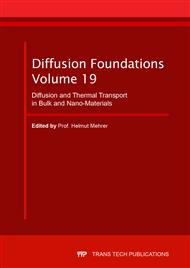[1]
Helmut Mehrer, Diffusion in Solids: Fundamentals, Methods, Matrials, Diffusion-Controlled Processes (Springer Series in Solid-State Science, vol. 155; Springer, Berlin, 2007).
Google Scholar
[2]
Matthew O. Zacate, Aurélie Favrot and Gary S. Collins, Atom Movement in In3La studied via Nuclear Quadrupole Relaxation, Physical Review Letters 92, 225901 (2004); and Erratum, Physical Review Letters 93, 49903 (2004).
DOI: 10.1103/physrevlett.93.049903
Google Scholar
[3]
G. Schatz and A. Weidinger, Nuclear Condensed Matter Physics (John Wiley, New York, 1996).
Google Scholar
[4]
Section 20.4, page 355, in ref.
Google Scholar
[5]
A. Baudry and P. Boyer, Hyperfine Interactions 35, 803 (1987).
Google Scholar
[6]
Gary S. Collins, Nonstoichiometry in line compounds, Journal of Materials Science 42, 19151919 (2007), http://dx.doi.org/10.1007/s10853-006-0055-2).
Google Scholar
[7]
Gary S. Collins, Xia Jiang, John P. Bevington, Farida Selim and Matthew O. Zacate, Change of diffusion mechanism with lattice parameter in the series of lanthanide indides having L12 structure, Physical Review Letters 102, 155901 (2009).
DOI: 10.1103/physrevlett.102.155901
Google Scholar
[9]
Gary S. Collins, Aurélie Favrot, Li Kang, Egbert Rein Nieuwenhuis, Denys Solodovnikov, Jipeng Wang and Matthew O. Zacate, PAC probes as diffusion tracers in solids, Hyperfine Interactions 159, 1-8 (2005).
DOI: 10.1007/s10751-005-9073-8
Google Scholar
[8]
Typical activation enthalpies for diffusion in intermetallics are much larger; see.
Google Scholar
[10]
G. S. Collins, A. Favrot, L. Kang, D. Solodovnikov and M.O. Zacate, Diffusion in intermetallic compounds studied using nuclear quadrupole relaxation, Defect and Diffusion Forum 237-240, 195-200 (2005).
DOI: 10.4028/www.scientific.net/ddf.237-240.195
Google Scholar
[11]
C. Michael Lederer and Virginia S. Shirley, Table of isotopes (John Wiley, Seventh ed., 1978).
Google Scholar
[12]
Megan Lockwood, Benjamin Norman, Randal Newhouse and Gary S. Collins, Comparison of jump frequencies of 111 In/Cd tracer atoms in Sn3R and In3R phases having the L12 structure (R= rare earth), Defect and Diffusion Forum, 311, 159-166 (2011).
DOI: 10.4028/www.scientific.net/ddf.311.159
Google Scholar
[13]
Xia Jiang, Matthew O. Zacate and Gary S. Collins, Jump frequencies of Cd tracer atoms in L12 lanthanide gallides, Defect and Diffusion Forum 289-292, 725-732 (2009).
DOI: 10.4028/www.scientific.net/ddf.289-292.725
Google Scholar
[14]
Qiaoming Wang and Gary S. Collins, Nuclear quadrupole interactions of 111 In/Cd solute atoms in a series of rare-earth palladium alloys, Hyperfine Interactions 221, 85-98 (2013).
DOI: 10.1007/s10751-012-0686-4
Google Scholar
[15]
Qiaoming Wang, Site preferences and jump frequencies of In/Cd solutes in rare earth palladium phases having the L12 structure, MS thesis, WSU, May 2012 (unpublished).
Google Scholar
[16]
Matthew O. Zacate and Gary S. Collins, Composition-driven changes in lattice sites occupied by indium solutes in Ni2Al3 phases, Physical Review B70, 24202 (2004).
Google Scholar
[17]
Matthew O. Zacate and Gary S. Collins, Temperature- and composition-driven changes in site occupation of solutes in Gd1+3xAl2-3x, Physical Review B69, 174202 (2004).
Google Scholar
[18]
Technical report 3 of grant NSF DMR 09-04096,, Site preferences and jump frequencies of In/Cd solutes in rare earth palladium phases having the L12 structure, MS thesis, Qiaoming Wang, May 2012, 76 pages. http://hdl.handle.net/2376/4187.
Google Scholar
[19]
Egbert R. Nieuwenhuis, Matthew O. Zacate and Gary S. Collins, Simultaneous measurement of tracer jump frequencies on different sublattices in Ga7Pd3 using PAC, Defect and Diffusion Forum 264, 27-32 (2007).
DOI: 10.4028/www.scientific.net/ddf.264.27
Google Scholar
[20]
John P. Bevington, Farida Selim and Gary S. Collins, Site preferences of indium impurity atoms in intermetallics having Al3Ti or Al3Zr crystal structures, Hyperfine Interactions 177 (1-3), 15-19 (2007).
DOI: 10.1007/s10751-008-9615-y
Google Scholar
[22]
M. Koiwa, H, Numakura, S. Ishioka, Diffusion in L12 type intermetallic compounds, Defect and Diffusion Forum 143-147, 209 (1997).
DOI: 10.4028/www.scientific.net/ddf.143-147.209
Google Scholar
[23]
WIEN2k, P. Blaha, K. Schwarz, G. Madsen, D. Kvasnicka and J. Luitz, Inst. f. Materials Chemistry, TU Vienna; http://susi.theochem.tuwien.ac.at.
Google Scholar
[21]
See, for example, Fig. 8.8, page 144, in ref.
Google Scholar


